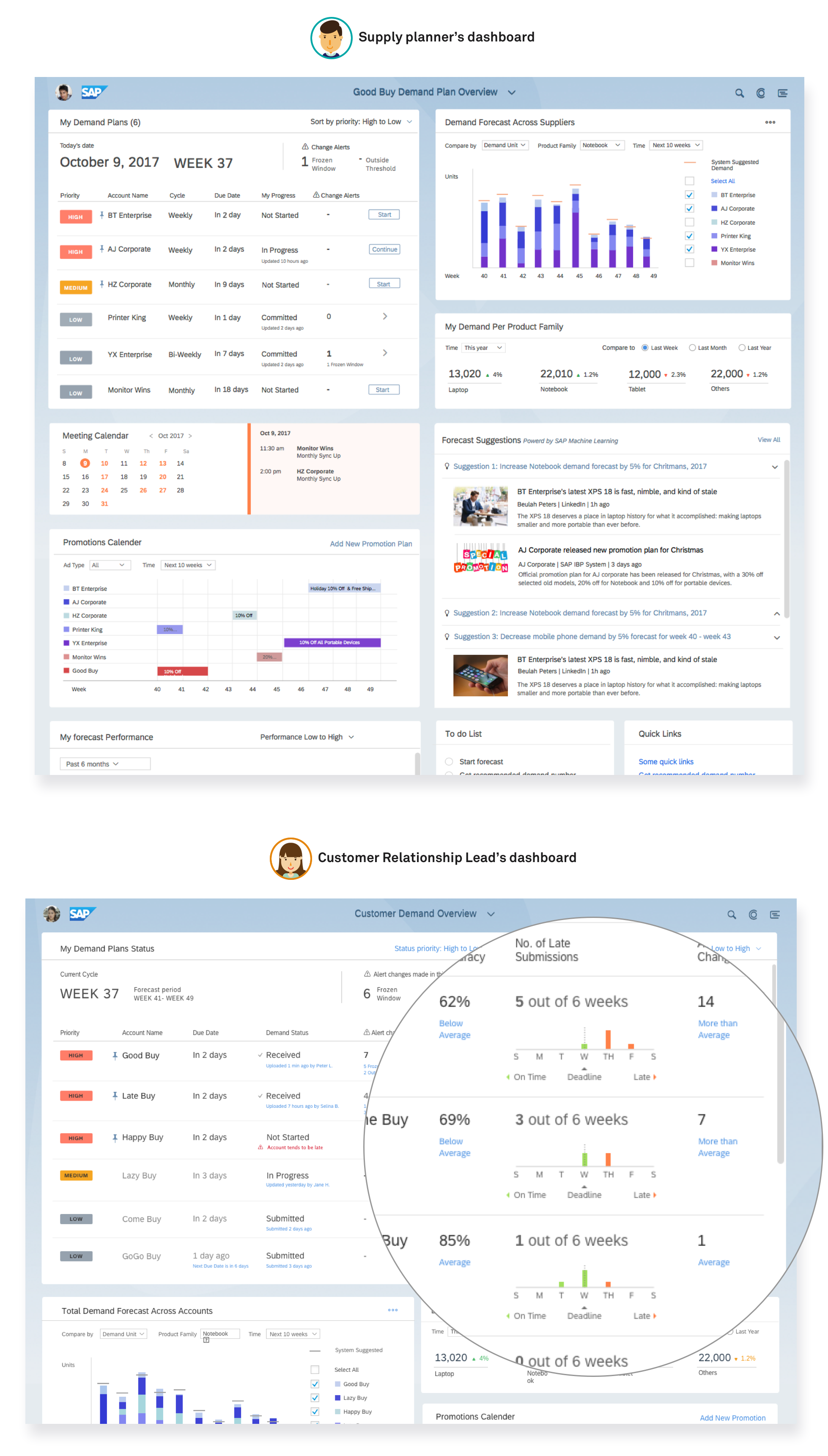
SAP | Business Network Collaboration

Challenge
How might we facilitate collaboration to make better demand planning?
Demand planning essential to let manufacture fulfill future demand profitably and efficiently. However, getting accurate demand forecast is hard because most retailers(customers) work passively with the manufacturers. Also, current software does not encourage collaboration. Thus, SAP IBP decided to launch the new capability, BNC(Business Network Collaboration) to enhance the collaboration.
Goal
Create the vision story that inspires product team for what Business Network Collaboration could be.
My Role
Conducted research, scoped the problem, iterated designs, and presented the final concept to product team with other 3 designers.
Background
What is demand planning?
Demand planning is the process of forecasting the demand for a product or service so it can be produced and delivered more efficiently and to the satisfaction of customers.
Solution Quick view
Make collaboration in “demand planning” easy and efficient

Dashboard
Monitor customer’s real-time status, and see the big picture
The role-based dashboard allows user to quickly manage the urgent task, and also see the overall performance to get long-term insights.

Demand planning table
Automatically highlight where needs discussion
Comparing customer’s demand and manufacture’s demand, the system could automatically highlight significant variation and initiate the discussion and collaboration.

Comments
Keep conversation trackable
To make communication easy to trace back, the system auto-saves comment and number history
Design process
Research
Understand what is the current demand planning process and stakeholders
To understand the context, flow and who we are designing for, we started from researching with our customers.

Research Methods
Learn from individuals, process to environments
We approached the problem from individual interviews. Since demand planning involves multiple stakeholders and various process, we did 18 interviews with 5 different roles to get a basic idea. We also validated the process in the design workshop. Lastly, we conducted contextual inquiries with 4 users to observe how they work and collect artifacts.
Research Digestion
Synthesize dots to top findings
Critical information is lost during collaboration
Customer-supplier collaboration is inefficient and inconsistent
Users struggle to understand the numbers

Research Summary
The general demand planning process with 3 types of collaboration
While each company has a different process, we could not make a product for each of them. Therefore, we came up with a general flow with different use cases.
* Customer relationship lead is equal to account manager.
Scope
Focused on demand collection, and defined main personas
To align with business direction, we narrowed the scope to demand collection. According to research, the Supply Planner from the customer side and the Account Manager from the manufacturer will be our primary persona. However, the Supply Planner is not a current SAP user.

User journey
Walk through pain points and opportunities
IDEATION
More, more, more ideas !!! And down to screens
We conducted 3 rounds of brainstorming. In the first round, we focus on quantity, so we captured thoughts by idea cards. In the second round, we roughly sketched the screen and variations. In the last rounds, we built ideas on others. Afterward, we conduct design critiques and selected the promising ideas to go further.
Design Evolution
From Lo-Fi to Hi-Fi, rough to details
We reviewed the design with the product team each week and added more details to make concept look more "real", such as "clear handover" and "drill down and aggregate data". We also tried to use the current SAP UI component as possible.






Final Design
Start with actionable and insightful dashboard
The roles-based dashboard includes a task list that is automatically prioritized by risk and urgency, a customized KPI that allow a user to evaluate the performance of what they are managing, and calendar with promotion plan and critical dates.

For customer relationship leads, they can see tack the collaboration from customer with forecast submission record. They might use this data for future negotiation with customer if the goods can not arrive as customer request urgently.
Plan in collaborative environment
Header shows due date and privacy status, which are critical for business collaboration. To help user digest large data, items are prioritized with machine learning technology. Also, the number could be highlighted if been changed or commented.
Make a better guess by simulation
To give user insights for forecast, simulation page shows the predicted number based on historical data, heat in social media, and industry news. User can also manipulate simulation attributes.

Discuss anytime, anywhere
To facilitate communication, comment and screen sharing in video chat are available. The conversation could be saved for record.

Results & Reflection
This is just beginning
The product team love the story and picked some of the features to implement in the next two quarters. However, as designers, we are more curious about end user’s feedback: Does our proposal solve their problems? How will they use it? Even though we tell a good story, but still lots of design came from assumptions. In product perspective, we need to validate the design with real users to optimize the solution.





